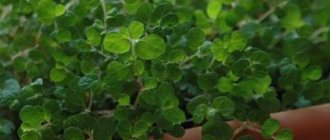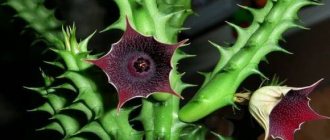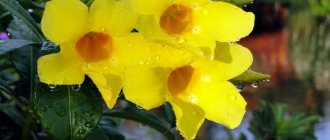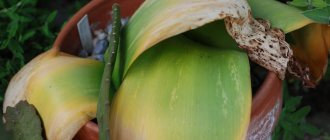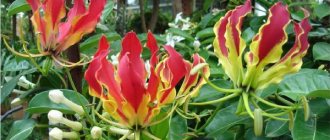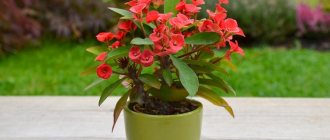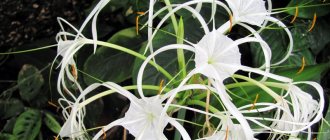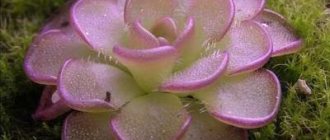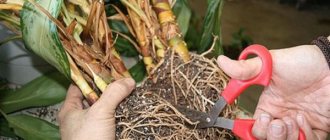Description of the plant
The plant received a specific name (Gasteria) for its yellow, green or orange flowers, which are shaped like a stomach. They are located on long (up to 80 cm) peduncles.
A young plant arranges its leaves in two rows; as it grows and develops, the arrangement of the leaves changes to a spiral one. Some species of Gasteria retain a two-row arrangement of leaves.
Depending on the species, Gasteria leaves vary greatly, they can take different shapes, the color varies from dark to light green. The pattern is mainly of white or light green spots of various shapes, and there may be raised warts on the surface or edges of the leaf. The fleshy leaf can be smooth or rough, flat or concave.
Features of flowering and dormancy of the plant
The main flowering period for gasteria is spring and the first half of summer. The flowering period usually lasts at least a month. It begins with the formation of an orange inflorescence from a rosette on the stem or on the foliage.
Even the smallest representatives of Gasteria have tiny flower stalks. They look like pot-bellied bottles; usually the main color is replaced by another less saturated one.
If care is followed, lush flowering appears. But you need to remember that if the pot with the plant is located on the northern windowsill, the chances of it blooming are very small. Peduncles usually appear in the spring or summer season; in appearance they resemble small bells, the shape of which is irregular.
The color of the flowers varies from pale pink to bright scarlet. One inflorescence can contain up to fifty small flowers.
If you want to get seed material, you need to periodically shake the peduncle to get pollen onto the stigma of the flower itself. When the period of active flowering continues, you should not change the location of the pot, change the temperature, lighting and basic care rules.
After the flowering period is over (this happens around the end of July - beginning of August), fruits appear in the place where the flower stalks were previously located, which are small boxes with seeds inside them. If seed material is not required, you can remove the fruits along with the remains of the inflorescence.
During dormancy, soil moisture should be reduced to a minimum, watering only when the soil surface dries out. Also during the rest period it is necessary to reduce the room temperature to 13 degrees. No feeding is carried out during this time.
Beneficial features
Gasteria warty. Photo
Gasteria spotted. Photo
In indoor floriculture, gasteria is valued not only for its decorative qualities, but also for its ability to filter air and absorb carbon dioxide from it, as well as various harmful impurities. This plant also releases a large amount of oxygen during photosynthesis, so it is recommended to place it, for example, in bedrooms.
How does it bloom?
With proper care, gasteria quite often pleases its owner with flowering. This happens in the spring months and lasts 25-30 days. First, a long orange peduncle appears from the basal rosette, then flowers form on it. The buds are often two-colored: one color smoothly transitions into another. In place of the dried peduncle, dense boxes with seeds are formed.
The photo shows a blooming gasteria:
Gasteria will not bloom, firstly, if you place the pot on a north window, and secondly, if you change the temperature in the room and move the plant from place to place.
If you want to achieve self-pollination, shake the peduncle from time to time.
You need to care for blooming gasteria as follows:
- Water with warm water.
- Feed with complex fertilizer for flowering plants, but reduce the concentration by one and a half times.
- There is no need to cut the peduncle - let it dry on its own.
Choosing a location and lighting
It is recommended to place a gasteria flower on an eastern, western or southern window, but with obligatory shading from the midday sun.
It will grow well on a north window, but will refuse to bloom. In winter, it is important to provide the gasteria with the brightest place in the room. The plant needs frequent ventilation
It is important to know that it does not tolerate drafts well. In summer, it is useful to take gasteria out into the fresh air, providing it with shading and protection from rain.
The optimal temperature for gasteria in summer is from 18 to 25°C, and in winter - from 10 to 12°C, but not lower than 6°C
Cool temperature during the cold season is an important condition for abundant flowering in summer.
Useful properties of gasteria
Gasteria warty.
Photo of Gasteria spotted. Photo In indoor floriculture, gasteria is valued not only for its decorative qualities, but also for its ability to filter air and absorb carbon dioxide from it, as well as various harmful impurities. This plant also releases a large amount of oxygen during photosynthesis, so it is recommended to place it, for example, in bedrooms.
Difference between Gasteria and Haworthia
The easiest way to distinguish these plants is when they are flowering . The petals of gasteria flowers are completely fused and tubular in shape. Havoria has a well-defined bent segment of the upper part of the petal, fused to half. Also, the young Gasteria plant is distinguished by its opposite leaves and large size, in comparison with the smallest succulent, Haworthia.
This video details the differences between three types of asphodel succulents - aloe, haworthia and nasteria:
So, gasteria is not only an exotic flower that, with minimal care, will delight the owner with a spectacular fan of leaves, but also a powerful amulet - so the signs say. And after the plant is in the bedroom, the owner will discover its beneficial properties, which include the ability to enrich the room with a large amount of oxygen at night.
Caring for gasteria at home (with photo)
As the practice of flower growers shows, with proper care, gasteria are extremely easy to grow. They do not have to be placed on a sunny windowsill and periodically turned towards the sun. They grow well in soil of any composition with abundant watering from spring to autumn. In winter, when the temperature drops to 5 °C, you don’t have to water it, but when you keep it in rooms with a temperature of about 21 °C, you need to water it periodically - without this, the tops of the leaves die.
Location. When organizing care for gasteria at home, you need to choose a bright sunny place, but the plant requires shading from the midday sun.
See how gasteria is cared for at home in the photo, which shows the best places to place a succulent:
It is recommended to place the plant in a bright place so that it receives direct sunlight for several hours.
In winter, gasteria should be moved to a cool room or kept in a bright window at room temperature of about 12-15 °C.
Humidity is normal, room temperature.
Substrate. The substrate is prepared from turf and leaf soil, sand and charcoal (1:1:1:0.5).
Watering. In summer, moderate watering is needed, but the soil should not be allowed to dry out. In winter at low temperatures - rare.
Like any succulent, gasteria can easily tolerate slight dry soil, so moderation should be observed when watering this plant. Excess moisture can negatively affect the condition of the root system.
Feeding. Twice a month the plant is fed with flower fertilizers in half the dose. During the period of intensive development, gasteria needs to be fed once a week using fertilizers for cacti. In winter, the plant does not require fertilizing.
Transfer. Gasteria are transplanted as necessary. To plant gasteria, it is necessary to prepare a soil mixture consisting of equal parts of clay turf, leaf soil and sand.
Rarely affected by pests and diseases. The main pests of Gasteria are aphids, scale insects and spider mites. Excess moisture in winter and lack of light in summer can cause leaves to wither and the stem of gasteria to rot.
Reproduction. Offshoots and seeds.
The following shows the care of gasteria in the photo, where all agrotechnical measures and the result of the painstaking work of the grower are visible:
All types of gasteria are used for succulent compositions in bowls and on rocky hills. This plant looks good not only in stylish office interiors and shop windows, it is ideal for any city apartment. Gasteria will be quite happy with a bright, sunny and well-ventilated window sill in your living room.
Choosing a location and lighting
The light-loving plant does not tolerate direct sunlight . The bright sun causes the leaves to lose patterns.
The best choice would be to place the pot on a windowsill on the south or west side of the house.
Attention! Gasteria develops well in light from an artificial source.
Bloom
The gasteria plant blooms rarely in indoor conditions and only if it is “satisfied” with the temperature conditions and light intensity. In spring or summer, long peduncles appear from the central part of the leaf rosettes, on which there are many graceful drooping amphora flowers with corollas painted in bright shades of red, orange, yellow and green.
Priming
Any substrate for succulents available in flower shops is suitable for cultivating the plant.
If you wish, you can make a soil mixture with your own hands: mix leaf soil, peat and sand in a ratio of 2:1:1.
Advice! To increase air and moisture permeability characteristics, you should add some brick granules.
Trimming
Most species of gasteria do not form stems, so this plant does not need formative pruning. However, during the process of growth, the flower gradually dries out the lower leaves - they should be removed regularly so as not to create a favorable environment for the proliferation of pests.
Temperature
Gasteria thrives at moderate temperatures ranging from +18-25°C. This is what applies to the spring-summer period, and in winter, when it has a dormant period, the temperature can range between +6-12°C. This temperature regime will ensure long and abundant flowering. If gasteria is not exposed to such changes, it is unlikely to bloom. When this plant is kept in winter, at higher (more than +15°C) temperatures, the inflorescences can dry out without leaving the outlet.
Air humidity
Gasteria does not need high humidity and easily tolerates room air. Like other succulents, it does not tolerate large amounts of moisture. Sometimes you can take a small shower to wash off the dust from the leaves. After bathing, you should protect the plant from the sun, as the leaves can get burned.
Land preparation and fertilizing
Gasteria grows well in a special soil mixture for cacti. You can prepare soil for the plant yourself from garden soil, mixed with coarse sand. Maximum comfort for the flower will be provided by soil composed of turf, leaf soil, peat with sand, subject to the proportions (5: 3: 2: 4).
To increase the drainage function, add brick chips or expanded clay, small crushed stone. Fertilizing is carried out only in the summer, when it is time to bloom. Using fertilizers for cacti is the best option.
How to feed:
- The feeding period is from May until September.
- You need to use fertilizer for cacti, but slightly reducing the concentration.
- The frequency of feeding is once every 14-21 days.
- They are very careful about adding nitrogen, reducing it to a minimum, since the plant reacts negatively to an excess of this substance, which provokes root rotting.
Watering and air humidity
The criterion for a flower's summer need for watering is the drying of the soil: excessive moisture is detrimental to the plant, as is prolonged drying out. During the winter season, the succulent can do without moisture completely.
Advice! If your apartment is hot in winter, you should water the flower every month.
The succulent is a representative of desert regions, so it prefers fairly dry air without the need for additional spraying. But he would appreciate a cool shower to clean the leaves of dust.
How to transplant gasteria?
Like other succulents, Gasteria grows very slowly. As a rule, a young flower requires one transplant per year, which is best done in the spring.
You can tell that it’s time to replant an adult plant by its overgrown root system, which occupies the entire container. The flower should be selected in a pot with a volume of 2–3 cm larger, giving preference to wide and shallow tanks. The transplant process occurs as follows:
- The bottom of the pot is covered with drainage material.
- The flower is taken out of the “old home” and, together with a lump of earth, is placed in a new one.
- Sprinkled with substrate.
In order for gasteria to grow lush and develop quickly, during its transplantation the children should be removed or replanted.
Rest period
The dormant period lasts from early September to mid-March. In preparation for this period, you need to remove all faded flower stalks, and also transfer the gasteria to a room where the air temperature fluctuates between 6-12°. No feeding is performed during the dormant period. Watering is moderate.
Features of transplantation
This flower grows very slowly, so it rarely needs replanting. Only in cases of extreme necessity, when the plant has little space in the pot or the container for planting was initially chosen to be too small. The optimal period for transplantation is spring; the procedure should be carried out no more than once every two years.
When replanting, you should prepare a large container, a drainage layer, and a soil substrate. A drainage layer is poured onto the bottom of the pot; the gasteria, together with the earthen lump, must be transplanted into a new container. Lightly compact the top by adding the required amount of substrate.
During transplantation, it is recommended to separate young children. This way the plant will grow faster. If you have just purchased a plant, you should not replant it right away (provided, of course, that the container size is suitable). It is recommended to choose a wide but shallow container for replanting the succulent.
Transfer
Transplantation is carried out in the spring. Young plants are replanted annually, adult plants once every 2-3 years, as needed. Choose a pot with a diameter slightly larger than the previous one, do not forget about drainage. Gasteria is removed along with the soil and transferred to a new container. Before this, the children are separated from it, this makes it possible for the flower to become more magnificent and beautiful. Sprinkle the required amount of fresh substrate on top.
Rest period
The succulent rests in the autumn-winter period, with the exception of spotted gasteria. Its dormant period occurs in the summer. During rest, the plant requires a lower temperature, up to +15 degrees, and does not need feeding at all.
Reproduction of Gasteria at home
There are three ways to propagate gasteria through seeds, leaf cuttings, and rosette.
Gasteria from seeds
Gasteria from seeds Photo of seedlings
- The seeds are placed on a moistened layer of sand; there is no need to sprinkle them on top.
- Containers with seeds are either covered with film or covered with glass to speed up germination.
- The temperature is set at 15-20 degrees Celsius, soil moisture is maintained by spraying.
- Sprouts will appear in 45-60 days.
- When 3-4 true leaves appear, the seedlings are planted in separate pots.
- The next transplant will be needed in a year.
The seed propagation method is simple, accessible and allows you to get many new specimens at once.
Little Varty
Gasteria little warty (G. little warty) is also known as the little wart. It has dwarf dimensions (height no more than 5 cm). The leaves have a dark green color and a smooth surface.
Propagation of Gasteria by leaf
Propagation of Gasteria by leaf cuttings photo
Leaf propagation is a common way to obtain new Gasteria specimens. To begin, prepare leaf cuttings.
- The leaves are carefully cut off, dried for 2-3 days, and immersed in the prepared moist but not wet soil mixture.
- Cuttings must not be watered!
- It is advisable to create conditions of high humidity: place the seedlings in an indoor aquarium or cover the pot with a jar, excluding direct sunlight.
- After planting, watering is possible only after 20-30 days, when the roots appear.
- Then water occasionally, about once every 7-10 days.
- You won’t be able to see the shoots soon; it may take about a year before the first shoot appears.
It will be possible to separate the shoots much later, when they grow at least 2 cm high and have their own roots. Any type of gasteria can be propagated by leaves; the method is especially interesting in cases where it is impossible to use seed propagation. If all operations are performed correctly, the result is positive in 100% of cases.
Reproduction of Gasteria by children
Gasteria sends out lateral shoots, also called babies. They also say reproduction by rosettes. This option is simple, effective, and preserves all the qualities of the variety. To transplant, you need to separate the “baby” rosettes. “Children” are immediately planted in pots according to their size.
- You need to very carefully dig up the baby along with a lump of earth under it and transplant it into a separate pot.
- It is enough to simply water and monitor the further development of the plant in the usual way.
- It is advisable to place the pot away from sources of heat and direct light.
- Creating greenhouse conditions will speed up the rooting of the baby.
- It is imperative to ensure drainage and not flood the plant: excess moisture will cause rot and the seedling will die.
Don't be surprised that the gasteria will remain unchanged for a long time: you need to be patient to see how the new specimen begins to increase in size.
Reproduction
There are several known options through which you can propagate gasteria. Among the most popular are the following:
- Seeds . Sand collected in a container with low walls is used as soil. To do this, seed material is sown on the surface of wet sand (you can moisten it with a spray bottle). After this, the seeds are not covered. The container is covered with transparent plastic film or glass. The air temperature in the room should be between 15-18°. As the top layer of sand dries, it should be moistened with a spray bottle. After the first shoots appear, the cover is removed. As the seedlings grow, they are transplanted into a new pot after 30-40 days.
- Children . This propagation option, according to experienced gardeners, is considered the most effective and affordable. Its use makes it possible to preserve the maternal properties of the species, which cannot be guaranteed during seed propagation. When transplanting, the babies are carefully separated from the mother plant (using a sharp knife or blade, which are pre-treated with a disinfectant solution). The children are planted in new containers of the appropriate size. Caring for a transplanted baby is no different from caring for an adult flower. In 2-3 weeks the baby will take root.
- Leaves . To propagate gasteria by leaves, it is recommended to use a healthy leaf blade, which is carefully separated from the mother plant. After cutting, the leaf petiole should dry for 2-3 days in a room protected from sunlight. To root it, use a container filled with wet sand. The container is covered with film and not watered for 2-3 weeks. After this time, the leaf cutting will produce young roots. After this, it can be transplanted to a permanent place of growth.
Variety of species
Of the eight dozen species of gasteria, only ten managed to adapt to life at home:
- Gasteria spotted
A succulent with a low trunk, the length of which does not exceed 30 cm. The leaf blades are smooth, with light oval spots, ending in spines. The flowers are red with a greenish border.
- Gasteria warty
The leaves form a two-row rosette, and a large number of daughter rosettes appear. The leaves are long, up to 20 cm, with grooves, covered with whitish growths. Pink flowers collected in clusters.
Gasteria warty
- Gasteria keeled
The leaves form a spiral rosette, they are shorter than those of Gasteria warty, their length does not exceed 14 cm. The surface of the plates is also covered with whitish-greenish warts, but their number is small and they are flat in shape.
- Gasteria tiny
The name speaks for itself - the flower has very modest dimensions. The rosette of this species consists of 4–6 cm leaves covered with spots and growths. The flowers are small, cute, pinkish-green.
Gasteria tiny
- Gasteria Armstrong
An even smaller representative of the species, the foliage of which grows to a maximum of 3 cm in length. The leaves have a wrinkled, rounded upper part, and the surface of the plate is covered with protruding dots. The flowers are small, pink in color, collected in brushes.
Gasteria Armstrong
- Bicolor
The foliage is ribbed, reaching 30 cm in length, covered with spots. Gasteria bicolor has larger leaf rosettes than other representatives of the species.
Gasteria bicolor
- Saber-shaped
This stemless succulent has sword-shaped plates with a glossy surface and white dots, collected in rosettes that can reach 30 cm in length. The flowers are red in color, located on a long flower stalk.
Gasteria saber-shaped
- Soddy
The flower has slightly convex leaves, which are arranged transversely in the rosette. Blooms with red or pink inflorescences.
Gasteria soddy
In addition, there are several hybrid varieties that are obtained by crossing gasteria of different species. The most popular among them is Little Varty - a miniature succulent.
Little Varty
When growing this flower, it does not matter what species it belongs to, since they are all inhabitants of hot climates and belong to succulents, which means they require the same approach and care.
Gasteria batesiana
At home, gasteria does not have great care requirements. However, some conditions still need to be met. This indoor plant loves fresh air, but when ventilating the room, it is better to remove the flower from the windowsill. Place your gasteria in the bedroom, because at night it absorbs carbon dioxide, and during the day it releases oxygen.
Gasteria batesiana
Gasteria verrucosa
A popular variety in indoor floriculture, it forms spectacular rosettes of long, dark green leaves, the surface of which is densely strewn with small white warts. Inflorescences appear on very long peduncles (up to 80 cm) and consist of several dozen small amphora flowers of red-green or pink-green color.
Armstrong's Gasteria (Gasteria armstrongii)
An unusual plant of compact size with very thick fleshy leaves of an oblong oval shape and a dark green hue. The plant blooms with small greenish-pink, elongated bell-shaped flowers, sparsely located on peduncles.
Gasteria succulent and its description
Dipladenia
Sem. Liliaceae
Genus gasteria duval
Homeland - South-West Africa.
Gasteria succulent is an ornamental leafy perennial herbaceous plant with or without a small stem. The leaves are short, sword-shaped, fleshy, decorated with brown or silver stripes. The inflorescence is racemose, emerging from the leaf axil. The flowers are tubular, drooping, 2-2.5 cm in diameter, pink, orange, white or red. Collected in racemes or panicles on an oblong peduncle, swollen at the base, with 6 petals. The capsules of Gasteria are triangular, leathery, and the seeds are small. An unpretentious indoor plant.
Distributed in South Africa. There are about 70 species in the genus. Ornamental plants, suitable for growing in rooms and winter gardens. Numerous hybrids are available.
It is common knowledge that all cacti are succulents, but not all succulents are cacti. Succulents are special plants, and Gasteria is no exception. It is capable of storing water in its leaves, which can often lead to its death, since it is believed that watering this flower is not necessary. Gasteria needs regular watering: in summer the soil should always be moistened, in winter the plant can be watered occasionally. With this care, it will grow beautifully and bloom with numerous orange, red and white flowers.
Blooms in April - May
You can read its description below and also look at the photo.
Growing errors and their consequences
If the rules of care are not followed, gasteria may appear painful.
- The leaves turn pale, wrinkle and soften - the soil is waterlogged.
- Dry brown spots appear on the leaves - drought in the soil.
- Wet brown spots appear on the leaves - a bacterial infection.
- The plant does not bloom - increased air temperature during the dormant period.
- The plant does not bloom well - the temperature is too low.
- The stem is rotting - waterlogging of the soil, lack of light.
As you can see, caring for gasteria at home puts forward a minimum of requirements. Having learned its character, you will easily cope with the maintenance of the plant and will admire the spectacular shoots and unusual flowers for a long time.
And for those who like to know more, we invite you to watch the video about gasteria
Problems with growing gasteria rarely occur. But sometimes, due to care errors, the decorative value of the flower is reduced. What mistakes do flower growers make most often? An analysis of the main problems can be found in the table.
Table - Errors in caring for gasteria, their consequences and solutions
Main symptomsWhat is the reasonWays to solve the problem
| Stretching of the rosette, thinning and elongation of leaves | — Lack of light | — Location of the gasteria in a more illuminated place; — illumination with fluorescent lamps |
| Bend edges of leaf plates, fading of warts and spots | — Failure to comply with the parameters of the rest period; — high temperature in winter | — Temperature drop in winter to 6-12˚С |
| Curling and drying of leaves | — Warm wintering | — Organization of a full rest period |
| Curvature, stretching of the gasteria | — Lack of space in the pot | — Transplant into a new pot; - placement of extra children |
| Leaves falling off when touched | — Excess moisture | — Reducing watering until the soil dries out completely; — normalizing the irrigation regime |
| Yellowish or reddish tint of leaves | — Excess of fertilizers | — Temporary cessation of fertilizing; — Subsequent use of fertilizers in a reduced dosage |
| Darkening and rotting of leaves | — Excess moisture at low air temperatures | — Replanting with removal of rotten areas; — Reducing watering |
The most common mistakes in care, diseases and pests of gasteria are the following:
- 1. Excessive waterlogging of the soil. The leaves of the plant turn pale, become limp, yellow and begin to rot. To restore the flower, you need to transplant it into a pot with good drainage and light soil. You also need to stop watering it for a while.
- 2. If the leaves curl and dry out, this may be a natural sign of aging of the plant. Such leaves are removed.
- 3. When there is insufficient lighting, the leaves become elongated and turn pale. Gasteria must be moved to a well-lit place.
- 4. If yellowed leaves develop patches of dry brown tissue, this is a sign of sunburn. The plant should be placed in a more shaded place and watered so that water does not fall on the leaves.
- 5. When attacked by a mealybug, a white sticky fluff, similar to cotton wool, appears on the stem. Gasteria stops growing. Such a plant must be completely removed so that it does not infect others.
- 6. If small cobwebs appear on the leaves and they turn yellow, this indicates a spider mite infestation. The plant must be treated with an acaricidal agent.
- 7. Brown plaques on the leaves and slower growth indicate the presence of a scale insect sucking the juice. If there are few insects, they can be removed with a cotton swab. It is recommended to treat areas where scale insects accumulate with alcohol and rinse with clean water.
Requirements for conditions of detention
Osteospermum, choose an annual or perennial crop
Gasteria is considered an unpretentious house plant that is suitable for beginners. However, it is possible to achieve flowering of gasteria only in favorable and comfortable conditions for it. In general, caring for this indoor flower is not difficult. By following basic rules, you can maintain its good condition for many years.
Lighting
Gasteria feels comfortable both in the shade and in the sun. It can be taken out into the open sky in summer; it is not afraid of the bright sun. However, excessive light in spring and early summer can lead to sunburn and discoloration of leaves - they turn burgundy-red. By autumn, gasteria restores the color of its leaves.
This plant feels much more comfortable in conditions of good lighting and diffused light. Tolerates artificial light remarkably well. The most favorable places for gasteria: south, south-east or south-west windows in the apartment.
Temperature
Room temperature (20-23 ˚С) is natural for this succulent. A decrease in temperature below 18˚C is responded to by a slowdown in growth. In winter, at home, it is necessary to protect the plant from drafts - remove it from the window during ventilation, and also not place it near heating devices, which instantly dry out the soil.
Diseases and pests
Succulents are most susceptible to infestation by aphids, mealybugs (hairy louse) and scale insects. Experienced flower growers advise inspecting flowers more often in order to detect these parasitic insects as early as possible:
- When infected with scale insects, the green leaves of the succulent become covered with brownish spots.
- Aphids are usually found on the underside of leaves, which curl up and lose their original color.
- When a plant is infected with a mealybug, a layer of sooty deposits appears on the surface of the leaf blades. It is extremely difficult to remove hairy lice and most often the infection leads to the death of the gasteria.
If pests are detected, it is recommended to treat the flower leaves with a soap or alcohol solution, and then with insecticidal agents.
Gasteria is a fairly strong plant and rarely gets sick, unless the owner himself may make mistakes in care, which can seriously harm the green pet. Here are the main mistakes in keeping this succulent:
- excessive fertilizing: the first sign of this is yellowed foliage;
- burn by direct sunlight - brown spots appear on the leaves;
- insufficient watering - the plates become covered with dry brownish spots;
- low lighting - gasteria becomes lethargic, the leaves become too elongated;
- excessive soil moisture - stem rotting occurs in winter;
- violation of the watering regime - the inflorescences fall off without blooming;
- When the soil dries out, the foliage turns yellow and dies.
It is important! The death of the flower may be false, so do not rush to throw away the gasteria. Perhaps the succulent has only lost its foliage, but its root is still viable and should be given a second chance by removing the dried parts and taking care of proper watering.
Sources
- https://pot-flowers.ru/sukkulenty/tsvetok-gasteriya
- https://komnatnie-rastenija.ru/gasterija-uhod-v-domashnih-uslovijah-foto-vidov-razmnozhenie/
- https://prorasteniya.com/komnatnye/sukkulenty/gasteriya.html
- https://kursi-floristiki.ru/komnatnye-cvety/gasteriya-foto.html
- https://2sotki.ru/gasteria.html
- https://ProZvety.ru/katalog-rastenij/sukkulenty/gasteriya-12-vidov-foto
- https://flowersfamily.ru/sad-i-ogorod/gasteria.html
- https://rastenievod.com/gasteriya.html
- https://rostok.info/komnatnye-rasteniya/sukkulenty/gasteriya.html
- https://chto-posadit.ru/rastenie-gasteriya-uhod-v-domashnih-usloviyah-foto-komnatnyh-vidov/
- https://flora-doma.ru/sukkulenty/gasteriya-pyatnistaya/
- https://wikiw.life/domashnij-uyut/cvety/gasteria.html
[collapse]

